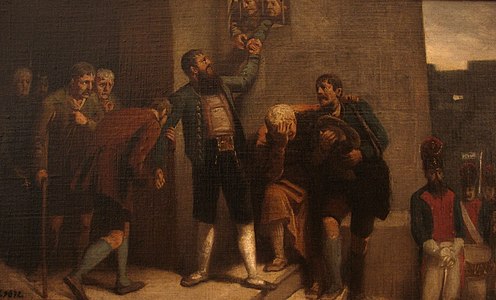Karl Karger
Karl Karger (born January 30, 1848 in Vienna ; † October 18, 1913 there ) was an Austrian painter and illustrator .
biography
Karger trained at the Vienna Academy of Fine Arts from 1864 and later in the studio of Eduard von Engerth , on whose cardboard boxes for the paintings for the Vienna Opera House he worked. In 1871 he went to Munich for some time and from there undertook a study trip to Italy , where he was particularly fascinated by the Venetian folk life.
In his first picture of a train station scene, painted in 1873 ( Österreichische Galerie Belvedere in Vienna), he expressed a keen eye for modern folk life by combining a painterly feeling with a happy selection of characteristic types.
The same advantages revealed a second picture from the traffic life: the ditch in Vienna , which Emperor Franz Joseph bought. In addition to numerous pencil and pen drawings, the following were created : the tax enforcement , the post office , the street scene in Venice and in 1880 three watercolors for the Crown Prince Rudolf album: the Queen of Belgium and Princess Stephanie in the Bois de la Cambre in Brussels , arrival in Laeken and reception of the Vienna men's choir at the Belgian court , where he achieved a great portrait resemblance with an extremely small scale of the figures .
Karger did even more in this direction at the singers' homage on the occasion of the pageant to celebrate the silver wedding of the imperial couple, where each of the numerous figures is filled with individual life and the difficult accusation is skillfully acquired a piquant painterly attitude.
Karger also worked as an illustrator (Wolff's “ Pied Piper of Hameln ”, Goethe's “ Clavigo ”).
As a professor at the School of Painting , around 1893 he was in charge of creating the compositions and executions of the sgraffito on the main page of the Austrian Museum of Art on Ringstrasse, after Ferdinand Laufberger's original boxes were lost. The executing students were Susanne Granitsch (1869–1946) for the allegories “Sculpture” and “Architecture”, Eugenie Breithut-Munk for “Ore Foundry” and “Ceramics”, Albert Wimmer (* 1870) for “Goldsmithing” and Johann Lukesch (* 1867 ) for "painting".
Karl Kager was buried in the Hietzingen cemetery in an honorary grave (group 18, row 4, number 90). In 1966 the Kargergasse in Vienna- Liesing was named after him.
Works (excerpt)
- Works by Karl Karger
- Andreas Hofer's last course , 1872. Oil on canvas, 29 × 50 cm, Heeresgeschichtliches Museum , Vienna.
- Arrival of a train at the Nordwestbahnhof in Vienna , 1875, oil on canvas, 91 × 171 cm, Österreichische Galerie Belvedere , Vienna.
literature
- Karger Karl. In: Austrian Biographical Lexicon 1815–1950 (ÖBL). Volume 3, Publishing House of the Austrian Academy of Sciences, Vienna 1965, p. 234 f. (Direct links on p. 234 , p. 235 ).
Individual evidence
- ^ Matriculation book for the Munich Academy: Albert Wimmer from Goslar (Prussia), entry: October 20, 1890, 20 years old; later worked in Leipzig, mentioned there in 1930
- ^ Matriculation book for the Munich Academy: Johann Lukesch, entered October 30, 1893, 26 years old
- ↑ on the website of viennatouristguide.at
Web links
- Entry on Karl Karger in the Austria Forum (in the AEIOU Austria Lexicon )
| personal data | |
|---|---|
| SURNAME | Karger, Karl |
| BRIEF DESCRIPTION | Austrian painter |
| DATE OF BIRTH | January 30, 1848 |
| PLACE OF BIRTH | Vienna |
| DATE OF DEATH | October 18, 1913 |
| Place of death | Vienna |


